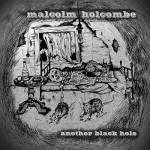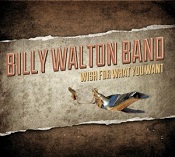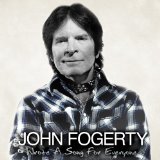 It’s just over six months since Malcolm Holcombe’s last album “The RCA Sessions” was released, so he’s obviously not spinning his wheels at the moment. “The RCA Sessions” was a retrospective with a twist, while “Another Black Hole” is ten new songs in the inimitable Malcolm Holcombe style. If your idea of a great voice is the kind of sanitised autotuned pap that you hear all over the radio, then we’d better say goodbye right here. Malcolm Holcombe has a voice that’s full of rugged character, matching the themes of his songs to perfection. As he sings in the title song, ‘The radio plays for the happy go lucky, that ain’t my set o’ wheels’.
It’s just over six months since Malcolm Holcombe’s last album “The RCA Sessions” was released, so he’s obviously not spinning his wheels at the moment. “The RCA Sessions” was a retrospective with a twist, while “Another Black Hole” is ten new songs in the inimitable Malcolm Holcombe style. If your idea of a great voice is the kind of sanitised autotuned pap that you hear all over the radio, then we’d better say goodbye right here. Malcolm Holcombe has a voice that’s full of rugged character, matching the themes of his songs to perfection. As he sings in the title song, ‘The radio plays for the happy go lucky, that ain’t my set o’ wheels’.
Throughout “Another Black Hole”, most of the usual collaborators are present, including Jared Tyler, David Roe and Ken Coomer and there are a couple of guest appearances from the legendary Tony Joe White, notably on the album’s rockiest song “Papermill Man”, which combines the themes of nostalgia and life at the bottom of the ladder that run through the album with a raucous, rambunctious musical romp.
The language and imagery are more measured, but this album reminds me of Springsteen’s “Wrecking Ball”, contrasting the Carveresque characters of the songs with the ‘suits and ties in the cubicles’ (“To Get By”) and the Vanderbilts who ‘hold the keys to the city’ (“Papermill Man”). If there was any doubt about where Malcolm Holcombe’s sympathies lie, “Don’t Play Around” nails it with the line ‘fuckin’ damn frackin’ and backroom stabbin’ knocks me down on my knees’. This is the ordinary, everyday Joe sitting in a bar and venting his anger over a beer before going outside to smoke a cigarette (and he makes it clear where that highway’s always going to end).
Malcolm’s voice may be a taste that you need to acquire, but the songs on “Another Black Hole” are beautifully-crafted vignettes of American life on the other side of the tracks, just out east of Eden. The playing’s perfect throughout, matching the music to the lyrical themes, without ever becoming overcooked. What more do you need?
Out now on Gypsy Eyes Music.
 So what’s been happening to the Billy Walton Band since the release of “Crank it Up” in 2012? Well, apart from the non-stop touring in the USA, Europe and the UK, the band has had a few line-up changes. Tenor sax player Rich Taskowitz has moved on and Billy has brought in Ian Gray (trombone) and Sean Marks (tenor and baritone sax) to fill out the band’s sound, moving away from a jazz set-up with two soloists to more conventional rock and soul lineup with frontman and backing horn section. It’s a slight change of emphasis, but it creates a more cohesive full-band sound underpinned by the rock-solid rhythm section of John D’Angelo (drums) and William Paris (bass).
So what’s been happening to the Billy Walton Band since the release of “Crank it Up” in 2012? Well, apart from the non-stop touring in the USA, Europe and the UK, the band has had a few line-up changes. Tenor sax player Rich Taskowitz has moved on and Billy has brought in Ian Gray (trombone) and Sean Marks (tenor and baritone sax) to fill out the band’s sound, moving away from a jazz set-up with two soloists to more conventional rock and soul lineup with frontman and backing horn section. It’s a slight change of emphasis, but it creates a more cohesive full-band sound underpinned by the rock-solid rhythm section of John D’Angelo (drums) and William Paris (bass).
For their fourth studio album, “Wish for What You Want” (released in the USA on Vizztone on January 27), the band has enlisted the services of respected producer Tony Braunagel and keyboard player Mike Finnigan, plus a few special guests from New Jersey and the tweaks seem to have paid off. As you might expect from the Billy Walton Band, the album works across many styles and genres, featuring strong songs and the usual high quality arrangements and playing; oh, and a bit of fun as well.
The album opens in a blast of horns and guitar with the uplifting rock and soul of “Wish for What You Want” and the first of many proper endings – none of your lazy fade-outs here and a standout track. “True Lovin’ Man” has a mid-tempo 70s feel, particularly in the horn arrangements before the blues stomper “Mountain” bursts in with a huge guitar riff. “Come on Up” is an organ-driven straight-ahead rocker, building up a head of steam before changing down a few gears for the country blues of “Blues Comes A Knockin’” featuring Southside Johnny on harmonica. “Forgive and Forget” takes the tempo straight back up again with the full band with organ and horns laying the foundation for Billy’s wah-wah guitar fills and solo. If the album gets a vinyl release, this is the perfect way to end Side One.
“Change” is exactly that, a brooding, atmospheric piece which channels Sergio Leone through Ray Manzarek before breaking into the straightforward blues chugger, “Worried Blues”. The next three tracks are probably the most commercial songs on the album; “Till Tomorrow” is a reworking of a “Crank It Up” song which adds a piano intro and plays down the horn fills. It’s a great song with a perfect guitar hook and in earlier times it would have been a perfect choice for a single. “Walk that Little Girl Home” is a Willy de Ville cover which mixes early Springsteen with The Drifters to evoke the Jersey shore perfectly and create another of the album’s highlights. “It Don’t Matter” has an E Street Band–inspired intro leading in to a “Take Your Job and Shove It” lyric which might or might not be autobiographical; it also features a great sax solo from Joey Stann; another former Asbury Juke. The album’s final track, “Hudson County Star” is loose blues/rock workout poking fun at corruption in the New Jersey political scene (a wide target, to be fair) which gives William Paris his customary shot at a lead vocal.
“Wish for What You Want” is another step forward for the Billy Walton Band. The band has evolved from the original power trio line-up focussing mainly on Billy’s guitar work to a rock and soul five-piece capable of covering a wide variety of styles. If you like your songs served up with big guitars and horns, then this one’s for you. If you decide that you like the album, then I’ve got a piece of advice for you; go out and watch the band live. You won’t regret it.
Released January 27 2015 on Vizztone.
I first saw Bobby Bandiera play in June 1995 at The Leadmill in Sheffield as part of an unplugged-style tour with Southside Johnny. I know; it’s a huge surprise that I was at a Southside Johnny gig, but you have to take my word for it. Looking back at it with the benefit of nearly twenty years of hindsight, the tour was probably an attempt to find out if Southside still had a following in the UK and whether a tour with a full band was a viable proposition. On the night, Johnny and Bobby were outstanding; it’s surprising how much variety you can squeeze out of two voices, a guitar and a few harmonicas. They played every request that came from the audience and proved that good songs are still good songs when all of the arrangements are stripped away. Before the gig, I knew that Southside was a great singer and harmonica player; after the gig, I knew that Bobby Bandiera was a hugely talented guitar player and a very, very good singer.
Bobby played in various bands on the Jersey shore following his debut in 1968, building a reputation as a gifted player and was considered as a replacement for Steve Van Zandt in The E Street Band for Springsteen’s “Born in the USA” tour. It didn’t happen, but in the following year he joined Southside Johnny and The Jukes, following the departure of Billy Rush and kicked off a collaboration which has lasted for nearly thirty years. I’m guessing that playing in The Jukes isn’t as lucrative as playing in the E Street Band, but it has other rewards.
I’ll come back to this later, but I truly respect any musician who naturally leads a band (whether it’s as a singer, guitarist or songwriter, and Bobby is all three) and can also take a back seat for a while and just be one of the players; Jimi Hendrix couldn’t do it, and he wasn’t the only one. When Bobby joined The Jukes they were mainly functioning as a live act and releasing albums that only the dedicated fans were buying but, from the very start to the present day, they remain a live phenomenon and Bobby has always been a perfect fit for Southside’s live performances. I’ve heard a story, from someone who knows, that Southside always likes to test any new Jukes (and there have been plenty of those) by suddenly, mid-gig, calling a tune that they haven’t rehearsed. I’m willing to bet that he never caught Bobby out that way because according to Billy Walton, another hugely versatile frontman and supporting guitarist, Bobby’s memory for songs is legendary.
There must have been a settling-in period but I’m guessing that it didn’t take very long for Bobby to become a perfect foil for Southside and give the singer a chance to drop down a few gears during live sets by passing the baton to his guitarist for a few songs. Leading any band isn’t easy, especially if you’re talking about nine or ten musicians and having Bobby Bandiera as a trusted lieutenant (in the same way that Springsteen has Steve Van Zandt in the E Street Band) helped keep the Jukes a tight live unit while adding another great voice to the mix. Any musician who joins The Jukes has to be a gifted player; you don’t play the same set night after night and you never know which song (or version of a song) is coming next. Apart from the challenge, the upside of this is that the musicians never get bored or complacent.
During twenty years with the Jukes, Bobby has also released three solo albums and continues to play live in New Jersey with the Bob Bandiera Band whenever he’s not touring in his current day job . Did I forget to mention that Bobby has been touring as part of Bon Jovi’s live set-up since 2005 in a supporting role? He’s usually described as rhythm guitarist, but I’m going to get all controversial on you here and say that there’s much more to it than that; the reason that Jon Bon Jovi wanted Bobby Bandiera in the touring band is that he needed a safe pair of hands. If your lead guitarist has had well-documented substance and reliability problems, then you need a reliable backup plan and Bobby Bandiera is about as reliable as they come; a tremendous guitar player who also adds very strong vocals. In April 2013, Richie Sambora left the tour at short notice and, in Canada, for one night only, Bobby Bandiera shook off the rhythm guitar tag and took on all the guitar duties, doing the job that he was brought in to do. It didn’t last long, as another shredder, Phil X, was brought in the next day to replace Sambora. And that incident kicked off all the predictable online spats between fans and friends on various sides of the debate (and not a serious word from any of the protagonists).
For what it’s worth, I’m not keen on bands bringing in extra players (for whatever reason)without giving them full bandmember status but, ultimately, it’s up to the players involved to do what they think is right. I don’t think you can criticise a musician for taking a supporting role which (presumably) pays well without the dubious benefit of a spotlight and big-screen shot; it’s a hard world out there as a professional musician and it’s getting harder.
I know it’s difficult if you live in the UK, but the best way to appreciate the artistry of Bobby Bandiera is to see him live. You can find YouTube clips of “C’mon Caroline” and covers of “Like a Hurricane” and “Baba O’Riley”, but the quality’s variable at best, and it’s almost impossible to find his albums online (at least at anything less than eye-watering prices). So, I guess the best I can hope for is that Jon Bon Jovi takes an extended break and Bobby comes back to the UK on the next Jukes tour; it’s unlikely but if it does happen, Music Riot will let you know about it then it’s up to you to go out and see him.
Some guitar players throw shapes and use smoke and mirrors (and the occasional wind machine) to grab your attention, but Bobby Bandiera doesn’t need any of that; he just has to play and sing. He’s a very modest guy who seems to be happy just to be doing something that he’s very good at, and that always looks and sounds good on stage. Whether he’s playing with his own band, The Jukes or a group of teenagers at a rock school, he’s always a great player to watch and he always looks like he’s having a great time. What more could you ask for?
 So, what’s this all about then? John Fogerty, former Creedence Clearwater Revival frontman and highly respected solo artist has decided to revisit some of his back catalogue with a few collaborators and throw in a brace of new songs for good measure. It’s not a new idea and it can be either a cynical attempt to cash in on a few good, old songs or a chance to invite fellow musicians to put their stamp on your songs. I’m really pleased to say that “Wrote a Song for Everyone” is a fascinating look at the heritage of one of the great rock songwriters and performers. You have to approach this with an open mind; some of the songs, in their original incarnations, were massive teenage favourites of mine through happy and sad times but there are some radically different interpretations here. The conventional view is that Eagles popularised the country-rock genre, but you could make the same case for Creedence if you take your country influences from New Orleans rather than Bakersfield; just a thought.
So, what’s this all about then? John Fogerty, former Creedence Clearwater Revival frontman and highly respected solo artist has decided to revisit some of his back catalogue with a few collaborators and throw in a brace of new songs for good measure. It’s not a new idea and it can be either a cynical attempt to cash in on a few good, old songs or a chance to invite fellow musicians to put their stamp on your songs. I’m really pleased to say that “Wrote a Song for Everyone” is a fascinating look at the heritage of one of the great rock songwriters and performers. You have to approach this with an open mind; some of the songs, in their original incarnations, were massive teenage favourites of mine through happy and sad times but there are some radically different interpretations here. The conventional view is that Eagles popularised the country-rock genre, but you could make the same case for Creedence if you take your country influences from New Orleans rather than Bakersfield; just a thought.
The album opens with “Fortunate Son”, which is amped-up by the Foo Fighters to a full-on rocker (no surprise there) before Keith Urban delivers a banjo-led country-rock version of “Almost Saturday Night” which takes the song back to its lyrical roots and “Lodi” (probably my favourite John Fogerty song) gets the Status Quo “Rocking All Over the World” treatment with John’s two sons Shane and Tyler Fogerty. Incidentally, this is the only collaboration that Fogerty arranged, pulling rank with his two sons when he didn’t like their country-rock arrangement. “Mystic Highway” is one of the new songs and breaks down into 3 sections, the main song, an instrumental section and an a capella breakdown with a strong feel of the Doobie Brothers “Black Water”. “Wrote a Song for Everyone” features a Miranda Lambert vocal and some exceptional guitar work from Tom Morello; so far so good.
The Zac Brown Band reworking of “Bad Moon Rising” in a Cajun style works less well for me, losing the brooding menace of the original version. “Long as I can See the Light” with My Morning Jacket sticks fairly close to the original, retaining the organ riff which characterises that version and is followed by Kid Rock’s take on “Born on the Bayou”. Apparently it’s now a violation of several federal statutes to record a collaboration album without including a Kid Rock track. The album’s second new song “Train of Fools” follows, exploring similar territory to Springsteen’s recent “Land of Hope and Dreams”. It’s obvious that John Fogerty can still write a good song and the new songs sit very comfortably alongside his earlier work on this album.
“Someday Never Comes” with Dawes has Taylor Goldsmith singing the verses about the things we tell kids (and adults) to shut them up while Fogerty takes the choruses as the gruff old bad guy who tells us that it’s all lies. Bob Seger delivers the Woodstock song “Who’ll Stop the Rain” very much in the style of his 1976 classic “Night Moves”, which works very well. If any singles are to be released from the album, “Hot Rod Heart” should be top of the list. It’s a great driving song (maybe it’s time we had an alternative to the lazy radio programming of Don Henley’s “The Boys of Summer” every time the sun shines for more than five minutes) and the last couple of minutes consists of Fogerty and Brad Paisley trading superb guitar solos and generally having a good time. I bet Paddy McAloon wouldn’t like it.
“Have You Ever Seen the Rain” with Alan Jackson works perfectly with a pure country arrangement with banjo, fiddle and steel guitar filling out the sound and leads us into the last track of the album. I’ve heard many versions of “Proud Mary”, but nothing quite like this. The first verse and chorus are pure gospel with Jennifer Hudson backed by a gospel choir and the wonderful Allen Toussaint before speeding up to a Cajun boogie with the full band and accordion and horns for good measure. I used to think the Ike & Tina Turner version was over the top, but they only used one kitchen sink and I think there’s about three here. It’s a glorious way to end a great album.
John Fogerty has survived in the music business for a long time with all of the usual peaks and troughs that anyone big in the sixties and seventies went through including the publishing disputes, particularly the publishing disputes. The reason he’s still around is that he loves what he does and he’s very good at it. “Wrote a Song for Everyone” is a very, very good album.
Out now on Vanguard (88765487152).



